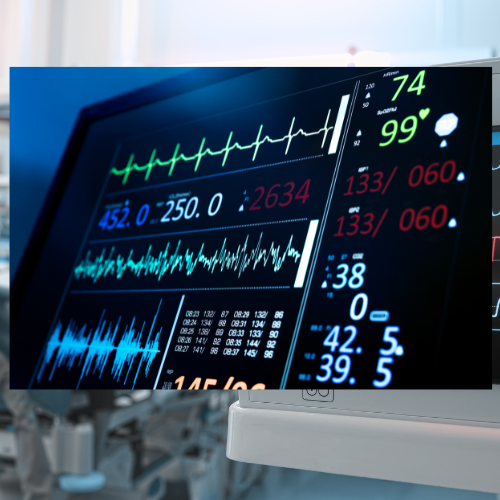ECG (Electrocardiogram): Understanding Heart Health through Electrical Activity (Health & Beauty - Health Services)

USNetAds > Health & Beauty > Health Services
Item ID 133237309 in Category: Health & Beauty - Health Services
ECG (Electrocardiogram): Understanding Heart Health through Electrical Activity | |
Introduction to ECG (Electrocardiogram) An Electrocardiogram (ECG) is a common, non-invasive test that measures the electrical activity of the heart. It provides valuable insights into the heart’s rhythm, rate, and overall function, enabling healthcare professionals to detect irregularities or potential problems. By examining the electrical signals generated during each heartbeat, doctors can assess the condition of the heart and diagnose a variety of conditions, from arrhythmias to myocardial infarction. The ECG is an essential tool in cardiology, often forming the first line of investigation when evaluating heart health. How Does an ECG Work? The heart operates through a complex system of electrical impulses, which stimulate it to contract and pump blood throughout the body. An ECG machine detects and records these impulses via electrodes placed on the skin, usually on the chest, arms, and legs. The test captures the timing and intensity of these impulses, displaying them as a series of waves on a graph. The P wave, QRS complex, and T wave represent various phases of the heart’s electrical cycle, and any abnormalities in these patterns can indicate issues like arrhythmias or blocked arteries. When is an ECG Needed? Types of ECG Tests There are several types of ECG tests, each serving different purposes: • Resting ECG: The most common type, performed while the patient is lying still. • Stress ECG: Conducted while the patient exercises to assess how the heart functions under physical stress. • Holter Monitoring: A portable ECG device worn for 24-48 hours to track the heart’s activity over an extended period. • Event Recorders: Similar to Holter monitors, but the patient activates the device when they feel symptoms. The Process of Getting an ECG The procedure for an ECG is simple and painless. After the electrodes are attached to the skin, the test typically takes only a few minutes. Preparation is minimal, though patients should inform their doctor of any medications they are taking as these can affect the results. Depending on the type of ECG, the entire process could last anywhere from a few minutes to 48 hours for long-term monitoring. Interpreting ECG Results Reading an ECG requires an understanding of the different waves that correspond to heart activity: • P Wave: Indicates atrial contraction. • QRS Complex: Represents ventricular contraction. • T Wave: Shows ventricular relaxation. A normal ECG shows consistent, evenly spaced waves. Any deviation from this pattern could indicate a heart problem, such as arrhythmias, ischemia (reduced blood flow), or electrolyte imbalances. Common Heart Conditions Detected by ECG • Arrhythmias: Irregular heartbeats, whether too fast, too slow, or erratic. • Ischemia: Reduced blood flow to the heart muscle, often due to blocked arteries. • Myocardial Infarction: Also known as a heart attack, detected through specific patterns in the ECG. • Electrolyte Imbalances: Abnormal levels of potassium, calcium, or magnesium can affect heart function and show up on an ECG. Benefits of ECG in Heart Disease Diagnosis ECGs are a key diagnostic tool because they are non-invasive, provide real-time data, and can be done quickly in a variety of settings. They help detect heart issues early, allowing for prompt treatment that can prevent more severe problems. Regular ECGs are particularly beneficial for people with known heart disease or those undergoing treatments that affect the heart. Who Should Get Regular ECGs? Routine ECGs are recommended for individuals with certain risk factors, including those with high blood pressure, diabetes, or a family history of heart disease. Athletes, the elderly, and people with chronic conditions may also benefit from regular ECGs to monitor their heart health and detect problems early. ECG vs. Other Heart Diagnostic Tests While an ECG is essential, it is often complemented by other diagnostic tools: • Echocardiograms: Provide ultrasound images of the heart. • MRI and CT scans: Offer more detailed imaging to assess structural abnormalities. Each test has its strengths, and doctors often use a combination to get a complete picture of heart health. Conclusion: The Role of ECG in Modern Medicine The ECG continues to be an indispensable tool in diagnosing and managing heart disease. Its ability to provide real-time, non-invasive insights into heart health makes it a vital resource for both patients and doctors. As technology advances, ECGs will become even more accessible, ensuring more people can benefit from early detection and improved heart care. Contact Us: 9136118883  | |
| Related Link: Click here to visit item owner's website (0 hit) | |
| Target State: All States Target City : All Cities Last Update : Oct 25, 2024 1:32 AM Number of Views: 40 | Item Owner : khushi heart care Contact Email: Contact Phone: (None) |
| Friendly reminder: Click here to read some tips. | |
USNetAds > Health & Beauty > Health Services
© 2025 USNetAds.com
GetJob.us | CANetAds.com | UKAdsList.com | AUNetAds.com | INNetAds.com | CNNetAds.com | Hot-Web-Ads.com | USAOnlineClassifieds.com
2025-02-24 (0.570 sec)